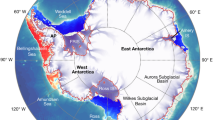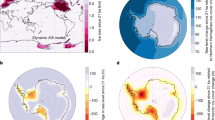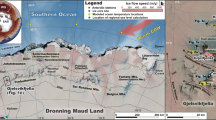Abstract
Changes in ice discharge from Antarctica constitute the largest uncertainty in future sea-level projections, mainly because of the unknown response of its marine basins1. Most of West Antarctica’s marine ice sheet lies on an inland-sloping bed2 and is thereby prone to a marine ice sheet instability3,4,5. A similar topographic configuration is found in large parts of East Antarctica, which holds marine ice equivalent to 19 m of global sea-level rise6, that is, more than five times that of West Antarctica. Within East Antarctica, the Wilkes Basin holds the largest volume of marine ice that is fully connected by subglacial troughs. This ice body was significantly reduced during the Pliocene epoch7. Strong melting underneath adjacent ice shelves with similar bathymetry8 indicates the ice sheet’s sensitivity to climatic perturbations. The stability of the Wilkes marine ice sheet has not been the subject of any comprehensive assessment of future sea level. Using recently improved topographic data6 in combination with ice-dynamic simulations, we show here that the removal of a specific coastal ice volume equivalent to less than 80 mm of global sea-level rise at the margin of the Wilkes Basin destabilizes the regional ice flow and leads to a self-sustained discharge of the entire basin and a global sea-level rise of 3–4 m. Our results are robust with respect to variation in ice parameters, forcing details and model resolution as well as increased surface mass balance, indicating that East Antarctica may become a large contributor to future sea-level rise on timescales beyond a century.
This is a preview of subscription content, access via your institution
Access options
Subscribe to this journal
Receive 12 print issues and online access
$209.00 per year
only $17.42 per issue
Buy this article
- Purchase on Springer Link
- Instant access to full article PDF
Prices may be subject to local taxes which are calculated during checkout




Similar content being viewed by others
References
Church, J. A. et al. in Climate Change 2013: The Physical Science Basis (ed Stocker, T.et al.) (Cambridge Univ. Press, 2013).
Bamber, J. L., Riva, R. E. M., Vermeersen, B. L. A. & LeBrocq, A. M. Reassessment of the potential sea-level rise from a collapse of the West Antarctic ice sheet. Science 324, 901–903 (2009).
Mercer, J. H. West Antarctic ice sheet and CO2 greenhouse effect: A threat of disaster. Nature 271, 321–325 (1978).
Schoof, C. Ice sheet grounding line dynamics: Steady states, stability, and hysteresis. J. Geophys. Res. 112, F03S28 (2007).
Pollard, D. & DeConto, R. M. Modelling West Antarctic ice sheet growth and collapse through the past five million years. Nature 458, 329–332 (2009).
Fretwell, P. et al. Bedmap2: Improved ice bed, surface and thickness datasets for Antarctica. Cryosphere 7, 375–393 (2013).
Cook, C. P. et al. Dynamic behaviour of the East Antarctic ice sheet during Pliocene warmth. Nature Geosci. 6, 765–769 (2013).
Rignot, E., Jacobs, S., Mouginot, J. & Scheuchl, B. Ice-shelf melting around Antarctica. Science 341, 266–270 (2013).
Hirabayashi, Y. et al. Global flood risk under climate change. Nature Clim. Change 3, 816–821 (2013).
Nicholls, R. J. & Cazenave, A. Sea-level rise and its impact on coastal zones. Science 328, 1517–1521 (2010).
Payne, A. J., Vieli, A., Shepherd, A. P., Wingham, D. J. & Rignot, E. Recent dramatic thinning of larges West Antarctic ice stream triggered by oceans. Geophys. Res. Lett. 31 http://dx.doi.org/10.1029/2004GL021284 (2004).
Jenkins, A. et al. Observations beneath Pine Island Glacier in West Antarctica and implications for its retreat. Nature Geosci. 3, 468–472 (2010).
Hindmarsh, R. C. A. The role of membrane-like stresses in determining the stability and sensitivity of the Antarctic ice sheets: Back pressure and grounding line motion. Phil. Trans. R. Soc. 364, 1733–1767 (2006).
Favier, L. et al. Retreat of Pine Island Glacier controlled by marine ice-sheet instability. Nature Clim. Change 4, 117–121 (2014).
Rignot, E., Mouginot, J. & Scheuchl, B. Ice flow of the Antarctic ice sheet. Science 333, 1427–1430 (2011).
Pritchard, H. D., Arthern, R. J., Vaughan, D. G. & Edwards, L. A. Extensive dynamic thinning on the margins of the Greenland and Antarctic ice sheets. Nature 461, 971–975 (2009).
Velicogna, I. & Wahr, J. Time-variable gravity observations of ice sheet mass balance: Precision and limitations of the GRACE satellite data. Geophys. Res. Lett. 40, 3055–3063 (2013).
Flament, T. & Rémy, F. Dynamic thinning of Antarctic glaciers from along-track repeat radar altimetry. J. Glaciol. 58, 830–840 (2012).
Aoki, S. et al. Widespread freshening in the seasonal ice zone near 140° E off the Adélie Land Coast, Antarctica, from 1994 to 2012. J. Geophys. Res. Ocean. 118, 6046–6063 (2013).
Williams, T. et al. Evidence for iceberg armadas from East Antarctica in the Southern Ocean during the late Miocene and early Pliocene. Earth Planet. Sci. Lett. 290, 351–361 (2010).
Bueler, E. & Brown, J. The shallow shelf approximation as a sliding law in a thermomechanically coupled ice sheet model. J. Geophys. Res. 114, F03008 (2009).
Pattyn, F. et al. Grounding-line migration in plan-view marine ice-sheet models: Results of the ice2sea MISMIP3d intercomparison. 59, 410–422 (2013).
Feldmann, J., Albrecht, T., Khroulev, C., Pattyn, F. & Levermann, A. Resolution-dependent performance of grounding line motion in a shallow model compared to a full-Stokes model according to the MISMIP3d intercomparison. J. Glaciol. 60, 353–360 (2014).
Comiso, J. C. Variability and trends in antarctic surface temperatures from in situ and satellite infrared measurements. J. Clim. 13, 1674–1696 (2000).
Timmermann, R., Beckmann, A. & Hellmer, H. H. Simulations of ice-ocean dynamics in the Weddell Sea 1 Model configuration and validation. J. Geophys. Res. 107, 10-1–10-11 (2002).
Walker, D. P. et al. Oceanic heat transport onto the Amundsen Sea shelf through a submarine glacial trough. Geophys. Res. Lett. 34, L02602 (2007).
Ha, H. K. et al. Circulation and modification of warm deep water on the central Amundsen Shelf. J. Phys. Oceanogr. http://dx.doi.org/10.1175/JPO-D-13-0240.1 (2014).
Ligtenberg, S. R. M., Berg, W. J., Broeke, M. R., Rae, J. G. L. & Meijgaard, E. Future surface mass balance of the Antarctic ice sheet and its influence on sea level change, simulated by a regional atmospheric climate model. Clim. Dynam. 41, 867–884 (2013).
Winkelmann, R. et al. The Potsdam Parallel Ice Sheet Model (PISM–PIK)–Part 1: Model description. Cryosphere 5, 727–740 (2011).
Hellmer, H. H., Jacobs, S. S. & Jenkins, A. in Ocean, Ice, and Atmosphere: Interactions at the Antarctic Continental Margin (eds Jacobs, S. & Weiss, R.) Oceanic erosion of a floating Antarctic glacier in the Amundsen Sea. 319–339 (Antarctic Research Series, Vol. 75, American Geophysical Union, 1998).
Acknowledgements
The study was partially financially supported by the German Federal Ministry of Education and Research (BMBF) and the German Environmental Foundation (DBU).
We thank R. Timmermann and H. Hellmer for providing ocean model data for temperature and salinity. Model development for PISM at the University of Alaska, Fairbanks, USA was supported by the NASA grants NNX09AJ38C, NNX13AM16G and NNX13AK27G.
Author information
Authors and Affiliations
Contributions
M.M. and A.L. designed the study and wrote the text. M.M. conducted the model simulations and prepared the figures.
Corresponding author
Ethics declarations
Competing interests
The authors declare no competing financial interests.
Supplementary information
Rights and permissions
About this article
Cite this article
Mengel, M., Levermann, A. Ice plug prevents irreversible discharge from East Antarctica. Nature Clim Change 4, 451–455 (2014). https://doi.org/10.1038/nclimate2226
Received:
Accepted:
Published:
Issue Date:
DOI: https://doi.org/10.1038/nclimate2226
This article is cited by
-
Increased warm water intrusions could cause mass loss in East Antarctica during the next 200 years
Nature Communications (2023)
-
Multiple episodes of ice loss from the Wilkes Subglacial Basin during the Last Interglacial
Nature Communications (2023)
-
Antarctic geothermal heat flow and its implications for tectonics and ice sheets
Nature Reviews Earth & Environment (2022)
-
Subglacial precipitates record Antarctic ice sheet response to late Pleistocene millennial climate cycles
Nature Communications (2022)
-
Response of the East Antarctic Ice Sheet to past and future climate change
Nature (2022)



